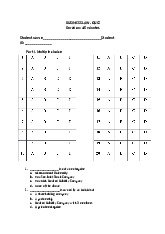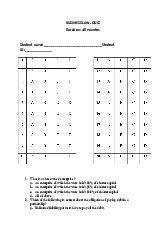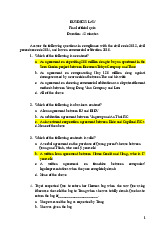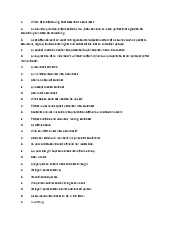





Preview text:
CHAP 7: ANALYZING ARGUMENTS
To analyze an argument means to break it up into various parts to see clearly what conclusion is being defended and on what grounds. I. Diagramming short arguments -
Diagramming is a quick and easy way to analyze relatively short arguments (roughly a
paragraph in length or shorter). - 6 steps :
1. Read through the argument carefully, circling any premise and conclusion indicators you see.
2. Number the statements consecutively as they appear in the argument (Don’t number
any sentences that are not statements.)
3. Arrange the numbers spatially on a page with the premises placed above the
conclusion(s) they are alleged to support.
4. Using arrows to mean “is evidence for,” create a kind of flowchart that shows which
premises are intended to support which conclusions.
5. Indicate independent premises by drawing arrows directly from the premises to the
conclusions they are claimed to support. Indicate linked premises by placing a plus
sign (+) between each of the linked premises, underlining the premises to the
conclusions they are claimed to support
6. Put the argument’s main conclusion at the bottom of the diagram. II.
Summarizing longer arguments -
The goal of summarizing longer arguments is to provide a brief synopsis of the argument
that accurately and clearly restates the main points in the summarizer’s own words. -
Summarizing involves two skills: Paraphrasing
Finding missing premises and conclusions 1. Paraphrasing -
A paraphrase is a detailed restatement of a passage using different words and phrases. New words and phrases : *Accurate •
none, or a very remote relation = little or no concern to us •
engaged in frequent controversies = embroiled in conflicts •
foreign to our concerns = don’t concern us •
it must be unwise = shouldn’t •
vicissitudes = ups and downs
2. Finding missing premises and conclusions -
An argument with a missing premise or conclusion is called an Enthymeme - 2 basic rules:
Faithfully interpret the arguer’s intention Be charitable III. Standardizing arguments -
Standardizing consists of restating an argument in standard logical form when each step
in the argument is numbered consecutively, premises are stated above the conclusions
they are claimed to support, and justifications are provided for each conclusion in the argument. - 5 basic steps:
1. Read through the argument carefully. Identify the main conclusion (it may be only
implied) and any major premises and sub-conclusions. Paraphrase as needed to clarify meaning
2. Omit any unnecessary or irrelevant material.
3. Number the steps in the argument and list them in correct logical order (i.e., with the
premises placed above the conclusions they are intended to support).
4. Fill in any key missing premises and conclusions (if any).
5. Add justifications for each conclusion in the argument. In other words, for each
conclusion or sub-conclusion, indicate in parentheses from which previous lines in
the argument the conclusion or sub-conclusion is claimed to directly follow.
CHAP 8: EVALUATING ARGUMENT I.
What good argument does not mean ?
1. Argument whose conclusion I agree with -
Reflects the mind-set of someone who thinks -
Such an attitude makes it impossible to learn from viewpoints that differ from one’own
and is completely opposed to the spirit of critical thinking 2. Persuasive argument -
Not all argument are meant to persuade. Sometimes the arguer is just “thinking ou loud”,
or giving examples without any intention of persuading -
Bad argument often persuade, whereaes good one often fall on deaf ears
Ex: in the year leading up to WW2, Hitler’s demagogic ravings convinced millions
whereas Churchill’s well-founded warnings were largely ignored
3. Well-written or Well-spoken argument -
We sometimes praise arguments for their literary or rhetorical merit – their clarity,
eloquence, orgnization, imaginativeness and the like -
Some bad arguments possess literary merit, whereas some good one do not -
Political speech may be a masterpiece of rhetorical skill and still be seriously flawed from
the standpoint of critical reasoning -
An argument in say, science or mathematics may be a perfectly good argument but
possess little or no literary merit II. What good argument mean ? -
A good argument, fundamentally, is an argument that is either deductively sound or inductively cogent -
The most critical thinking standards are: Accuracy Logical correctness
Clarity, precision, relevance, consistency, completeness and fairness III.
When is it reasonable to accept a premise ? -
In general, it is reasonable to accept and unsupported claim as true when:
Does not conflic with personal experiences that we have no good reason to doubt
Does not conflict with background belief that we have no good reasons to doubt Comes from a credible source 1. Personal experience -
People often place too much trust in their own observation and experiences -
Personal experiences are often less reliable than we think
Critical thinkers recognize that their beliefs, hopes, fears, expectations and biases can affect their observations 2. Background belief -
Background beliefs – a vast network of conscious and unconscious convictions we use as
a framework to assess the credibility of claims that cab’t be verified directly -
The problem is most of us place too much confidence in the accuracy of our background beliefs -
Consequently, if our background beliefs are unreliable, any beliefs based on them will also be unreliable
Critical thinkers think very carefully about the beliefs they accept. Never believe with
out sufficient evidence and never believe more strongly than the evidence warrants 3. Credible source
Critical thinkers must ask “Are all premises true ?” and “Do the premises provide
good reasons to accept the conclusion ?” IV. Refuting arguments -
To refute an argument is to defeat it – to show that the premises do not provide good
reasons to accept the conclusion - 2 ways to refute an argument:
Show that a premise or a critical group of premises is false or dubious
Show that the reasoning is bad – that the premises do not provide adequate logical support for the conclusion.
CHAP 11: INDUCTIVE REASONING
1. Inductive Generalizations -
Inductive generalization is an argument that relies on characteristic of a sample
population to make a claim about the population as a whole -
Là cách sử dụng dẫn chứng của một bộ phận người để nói về cả tổng thể, mọi người -
Ex: I know five or six truck drivers, and all of them are Democrats. So, probably most truck drivers are Democrats
Câu kết luận tổng quát được kết luận từ KINH NGHIỆM CÁ NHÂN và TỪ DẪn CHỨNG NHỎ (5 or 6 drivers)
Để hiểu được Inductive Generalization:
+ Xác định Sample population and Population as a whole
+ Making Inductive Generalization stronger by making conclusion weaker
Ví dụ 1: All the bass Hank caught in the Susquehanna have been less than 1lb. So, most of the bass in
the Susquehanna are less than 1lb.
->ở câu trên, nó khá là yếu về lập luận, ngay cả khi Hank câu cá thường xuyên, thì con sông S đó khá lớn
và số cá Hank bắt đc không đủ để đưa ra kết luận. Tuy nhiên, nếu ta thay đổi chứ MOST ở câu kết luận
thành SOME/MANY thì câu trên sẽ trở lên mạnh hơn.
Ví dụ 2: Only 3 percent of IU are against building the new gymnasium, A is a IU student,
So, A is not against building the new gymnasium.
->Ở đây, muốn là nó mạnh hơn thì ta chỉ cần thêm chữ Probably/Likely ở câu kết luận.
* Evaluating inductive generalization: 1. Are the premises true ?
2. Is the sample large enough ?
3. Is the sample representative or typical of the population as a whole ?
=> Inductive generalization is good only when “Yes” for all 3 questions
Note: cách nhận diện câu này là sample size quá nhỏ 2. Statistical argument -
Statistical argument argues from premises regarding a percentage of population to a
conclusion about an individual member of that population or some part of that population - >80%: strong and reliable - >50%: strong but unreliable - <50%: weak -
Nếu muốn làm nó strong hơn khi đang ở trạng thái weak thì thêm probably ở câu kết luận
3. Induction and analogy -
Anology is a comparison of things based on similarities those things share Recall weak analogy - A có X B cũng có X A có Y Suy ra B cũng có Y -
Muốn so sánh thì gồm 3 bước:
True premises (câu tiền đề phải đúng)
The relevance of the similarities (sự liên quan của tính tương đồng)
The number of relevance of the similarities (số lượng sự liên quan của tính tương đồng)
Evaluating arguments from analogy
Ex 1: A và B đều cao và chơi bóng rổ
Mà A cũng chơi bóng chuyền nữa đó
Zậy chắc con B chắc chẵn cũng (must) chơi bóng chuyền
Number of relevance similarities: 2 ( tall + play basketball)
Ex 2: A, B, C và D đều cao và chơi bóng rổ
Mà A,C và D đều chơi bóng chuyền nha
Zậy là con B chắc chắn cũng (must) chơi bóng chuyền (narrow, specific)
Tại khi mà mày tăng sample size lên thì tính chính xác cũm lên được xíu => Stronger argument Nhưng mè: Khi mà mày nói :
+ B chắc chắn đã chơi (must have played) bóng chuyền vào 1 lúc nào đó (at some time)
+ B có lẽ (may) chơi bóng chuyền
+ B có lẽ đã chơi (may have played) bóng chuyền vào 1 lúc nào đó (at some time)
Thì câu của mày sẽ rộng nghĩa hơn, ít chính xác (broader, less specific)
4. Induction and causal argument - Cause and effect -
A cause that brings about a change, produces an effect -
Causal terms: cause, produce, is responsible for, affects, makes, changes and contributes to
Evaluating causal arguments: -
Ở phần này có 2 dạng argument:
Single instance (nói về cá nhân thui ớ nha):
Megan’s car wouldn’t start this morning, and she hasn’t replaced the battery since she
bought the car six years ago. So, it is probably a dead battery that caused the car not to start.
General relationship (thường là nghiêng về nghiên cứu, khoa học)
The Surgeon General has found that there is a strong link between smoking cigarettes
and getting lung cance. So, smoking cigarettes causes lung cancer. Correlation and cause:
Correlation: 2 things are frequently found together
Positive correlation: 2 things are found together more than 50% of the time
Negative correlation: 2 things are found together less than 50% of the time




